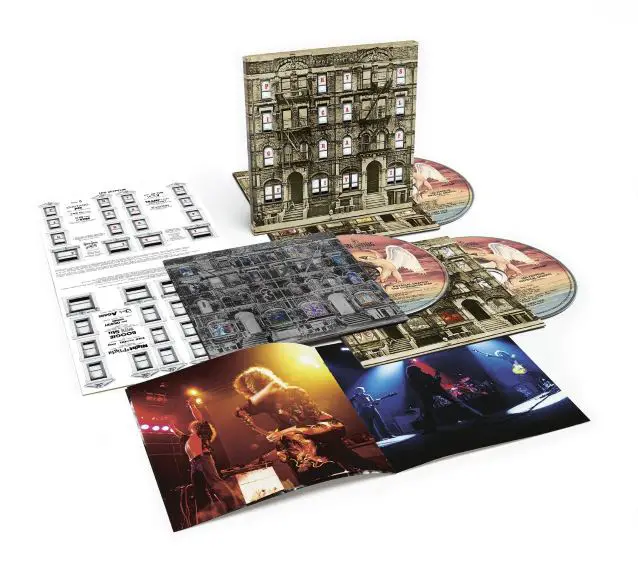LED ZEPPELIN‘s 1975 abum “Physical Graffiti”, which just was reissued in expanded form, sold around 40,248 copies in its first week of re-release to land at position No. 11 on The Billboard 200 chart. This marks a 6,875 percent increase in sales compared to the previous week’s total of 577.
LED ZEPPELIN‘s expanded three-disc reissue of “Physical Graffiti” features seven previously unissued alternate tracks and outtakes — in addition to remastered versions of such ZEPPELIN classics as “Kashmir”, “Trampled Under Foot”, “Houses Of The Holy”, “In My Time Of Dying”, “Down By The Seaside”, “Boogie With Stu” and “The Wonton Son”, among others.
According to The Pulse Of Radio, Jimmy Page credits the outtakes featured on “Physical Graffiti” for helping define the band’s beloved double album set. Just under half of the set was culled from the band’s three previous albums — but none were discarded at the time due to their quality, but rather for not fitting the vibe of their parent album. Page told The Pulse Of Radio that with the extra room available on “Physical Graffiti”, there finally was room for these orphan tracks to find a place.
The Pulse Of Radio asked Page if he knew going in that “Physical Graffiti” was going to be a double album — and whether half the set would be comprised of outtakes from the band’s previous albums. “I thought about it, but it was as good as the material that we came up with,” he said. “I knew it was going to be fun to revisit this stuff and sort of even go retro on ourselves. There’s not many… Nobody had done that, really. Not that I know of. And I just thought that it would be really good to add even more colors to the pallet. Because there was such variety across the other albums, and just to make something that was such a statement, that ‘this is what we do, and how we do it, and nobody is anywhere near it.'”
Page explained his pre-production creative process for working on tracks for what became LED ZEPPELIN‘s only double studio album. “I had the luxury of having a home studio, a multi-track studio at home,” he said. “And we had a little bit of time off; so we weren’t doing concerts, concerts, concerts — a bit of time off, so I was able to get in there and just really enjoy myself. Trying textures and overlays and various ideas. And one of the things that I had pre-getting to gather (with the band) at Headley (Grange) was the whole structure of ‘Ten Years Years Gone’ with all the… ’cause I wanted to get all the orchestrated guitar parts together, so that I didn’t waste time when I was there. ‘Cause I could hear ’em in my head and I just wanted to sort of lay ’em down so it would be much easier to sort of present it to the rest of the band as a piece ’cause it was gonna be quite long.”
Regarding the album’s die-cut cover, Page explained the idea was an extension from the wheel that first appeared on the cover of “Led Zeppelin III”. “The reality of that was that you’d never actually see everything that was on the wheel,” Page said. “I’m sure the record company sort of cursed the whole idea… It was a bit sort of mischievous saying, ‘Right, let’s try the same idea, but we’re going to make it a bit more user-friendly so you can actually see everything that’s on the inside.'”
Source: Blabbermouth
